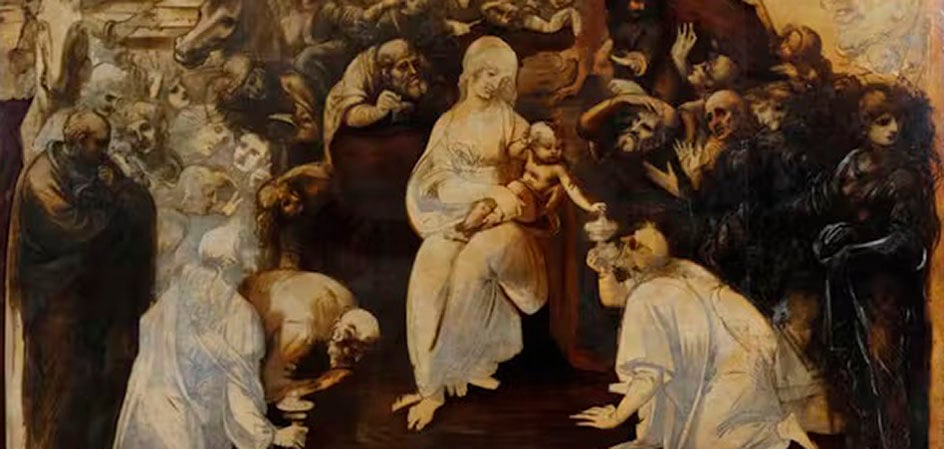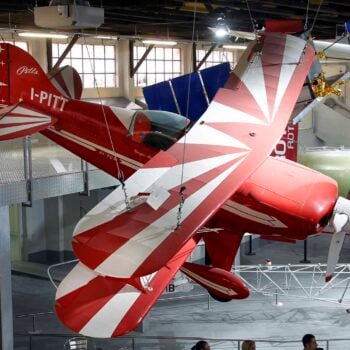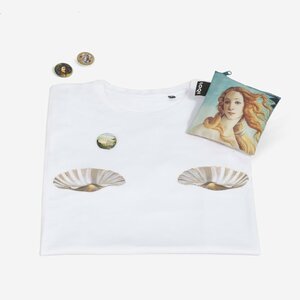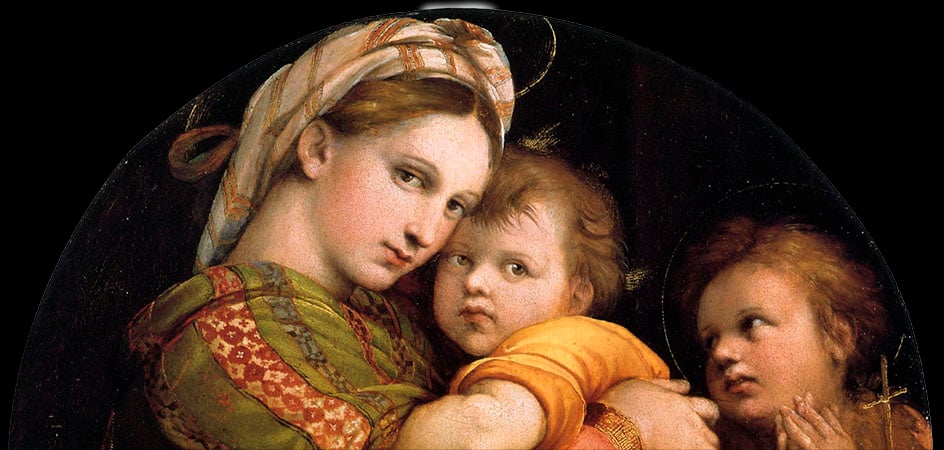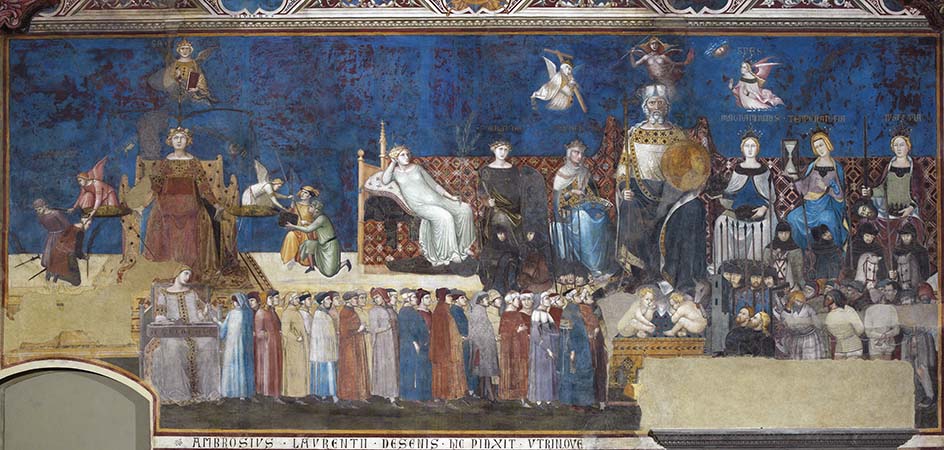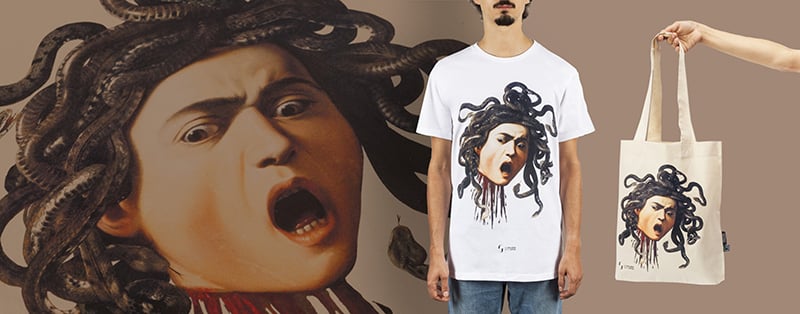A common fate links all the surviving works of Leonardo: none, it seems, were completed. The most striking example is the Adorazione dei Magi, begun in the late 15th century and never finished. Its unfinished state does not diminish the allure of the work or the genius of the artist, who once again demonstrates unparalleled intellectual vibrancy here.
The large panel (244 x 240 cm) occupies the central wall of the sala di Leonardo in the Galleria degli Uffizi, where it has been housed since the 17th century. Recently subjected to a masterful restoration, this masterpiece has much to tell us.
Origin and history of the enigmatic painting
In July 1481, Leonardo was commissioned by the monks of Sant’Agostino to create an altarpiece for the main altar of the San Donato a Scopeto convent. The church was located on a small hill outside Porta Romana in Florence but was destroyed during the siege of 1529 and no longer exists today. It is likely that Leonardo was recommended to the monks by his father, the powerful notary Piero di Vinci, who often promoted his illegitimate but talented son.
The contract stipulated that Leonardo would work on the altarpiece for 24 months, up to a maximum of 30, but the work never reached its destination.
After about a year, Leonardo left for Milan, invited to the court of Ludovico il Moro, abandoning the painting. The clerics hoped in vain for a resumption of the work. Almost 10 years later, they commissioned Filippino Lippi, who completed his work in 1496.
The Adorazione dei Magi by Filippino Lippi – also in the Uffizi – was displayed inside the church. Comparing the two reveals compositional similarities that cannot be coincidental or attributed solely to the common subject and commissioner. Lippi likely observed Leonardo’s unfinished altarpiece and drew inspiration from it.
A clear element of similarity is the semicircular arrangement of the subjects, with the Vergine and Bambino at the center.
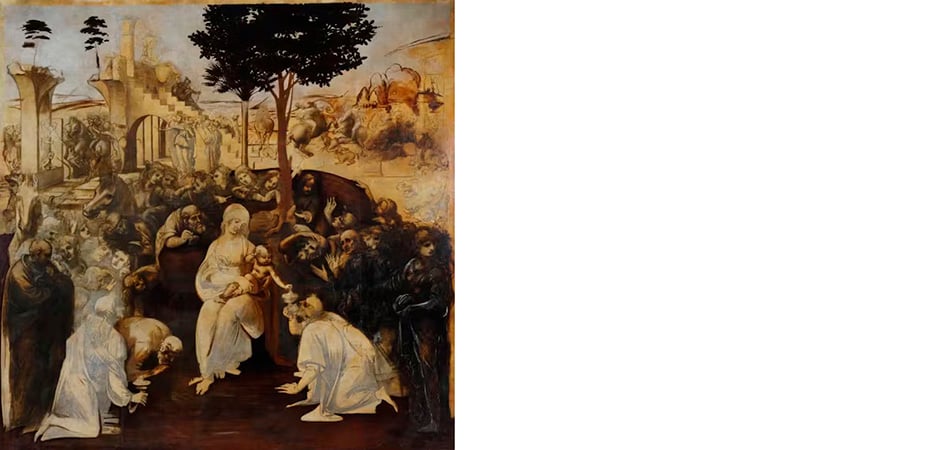
Iconography and interpretations of the Adorazione dei Magi
The painting is at various stages of completion, with some figures barely sketched and others more defined, showing signs of revisions and cover-ups. However, the theme is clear: the Epifania, the moment when the Magi come to pay homage to the Salvatore. The three Magi are recognizable, though not precisely identifiable, as the kneeling figures in the foreground: two on the left side, one younger and one older, and the third, elderly, on the right, offering a gift to the Bambino.
Behind Maria, a bearded man holding an object is visible. Critics have identified this figure as San Giuseppe receiving a gift, a recurring motif in Florentine painting of the period, as seen in Beato Angelico’s fresco in the San Marco convent.
Surrounding the central group, in the background, is a crowd of people, while a fight between knights takes place in the background. On the opposite side, a structure with arches and stairs can be seen, with figures above it. Scholars have tried to decipher these elements.
Starting from the left, the man in a dark cloak with a pensive air could be Isaia. In his book, the prophet describes the arrival of peoples from around the world to proclaim the glory of the Salvatore. According to his prophecy, peace would follow wars and destruction, with the rebirth of the Temple of Jerusalem. This interpretation also explains what is seen behind the main scene: a battle in the countryside resolving into the reconstruction of Salomone’s temple, with workers and laborers. What might initially appear as ruins is instead a palace under restoration, symbolizing rebirth. Separating the two moments is the palm of martyrdom.
Isaia’s pages also help explain the presence of the other tree, likely a laurel, symbolizing immortality, rising from the central core to the upper edge of the panel. It is the Tree of Jesse, from which the genealogy of the Vergine and the Bambino descends. Next to the trunk, on the right, a figure touches the roots and points to the leaves, alluding to the Messia’s rebirth. This is also where the focal point of Leonardo’s preparatory perspective lines, not entirely removed, is concentrated.
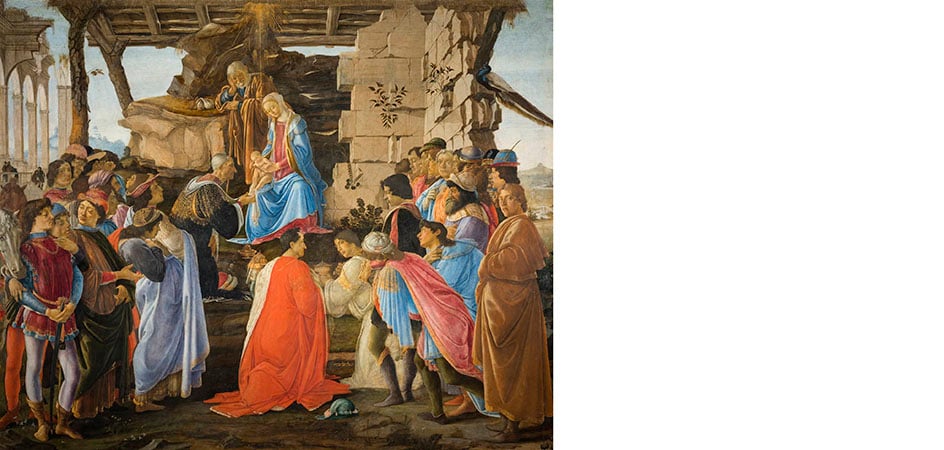
On the right side, three more figures are the subject of investigation and conjecture. The standing knight, the counterpart to the presumed Isaia, is thought to be a self-portrait of Leonardo at thirty, following the contemporary custom of representing oneself in one’s paintings (as seen in the Adorazione dei Magi by Botticelli, also in the Uffizi).
The bald man in the middle of the right group resembles the emaciated features of San Girolamo, depicted by Leonardo in 1481 and now in the Pinacoteca Vaticana.
During the restoration, an inscription (not visible to the naked eye) was found under the bearded man addressing the Bambino, covering his forehead as if shielding himself from a bright light, identifying him as Giovanni: possibly Giovanni da Bologna, prior of the Scopeto convent.
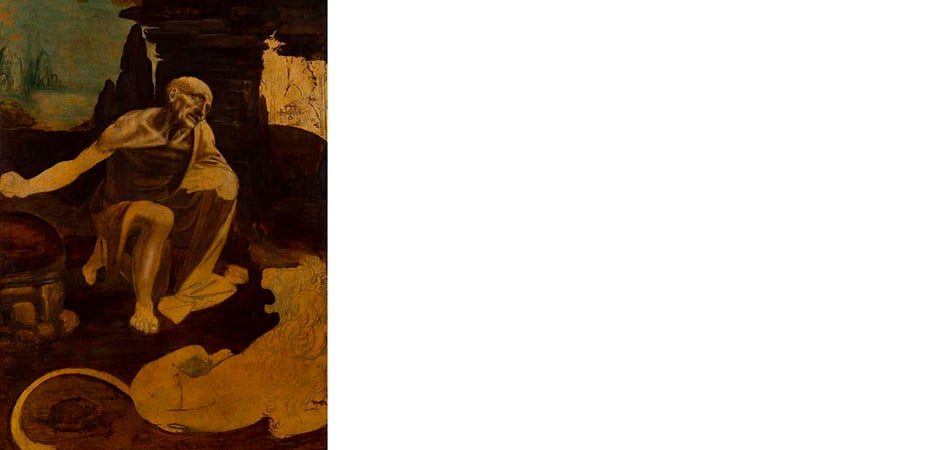
What the extensive restoration revealed
From 2011 to 2017, the panel underwent meticulous restoration by the Opificio delle Pietre Dure in Florence. The intervention was deemed necessary to preserve the work’s quality and the integrity of its wooden support. Many discoveries emerged during the cleaning of the painting. The most significant is that Leonardo drew everything freehand, without preparatory cartoons, as was his usual practice. Numerous changes and corrections to the placement and movements of some characters are visible, for example, in the dark area on the right. This indicates that the artist was still envisioning the final composition and often changed his mind, despite having already studied it in two previous sketches, now housed respectively in the Louvre and the Gabinetto di Disegni e Stampe in the Uffizi.
Leonardo also experimented with new solutions for preparing the panel. To the traditional mixture of gypsum and glue, he added plant fibers, a practice then common only in northern countries, which would have contributed to giving elasticity to the wooden boards.
Infrared investigation also revealed that the rock on which the Vergine rests her feet opens into a sort of well or chasm. Below it, a watercourse likely flowed – hinted at by the lighter brushstrokes – as seen in the two subsequent versions of the Vergine delle Rocce in Paris and London.
Are you interested in articles like this?
Sign up for the newsletter to receive updates and insights from BeCulture!
Today, we can enjoy the exceptional spectacle of this work thanks to the relatively good conservation conditions before it arrived at the Uffizi. Before joining the Galleria’s collection, the Adorazione dei Magi remained in the Palazzo of Santa Croce of Giovanni di Amerigo Benci. It is imaginable that the wealthy merchant, a friend of the Vinci family, allowed Leonardo to use one of the palace’s rooms as his workshop to create the altarpiece, and that it remained there when the artist left Florence for Milan. It was here, at casa Benci, that Vasari first saw it in 1568.
“It is clear that Lionardo, for his understanding of art, began many things and never finished any, thinking that his hand could not achieve the perfection of the things he imagined […]” wrote the biographer in his Vite.
In this sense, the Adorazione dei Magi is no exception. The variety of details and expressions of the portrayed characters, the fidelity of the botanical depiction, and the material experimentation all testify to Leonardo’s broad interests and his uncontainable versatility, despite – or perhaps because of – its unfinished state.


